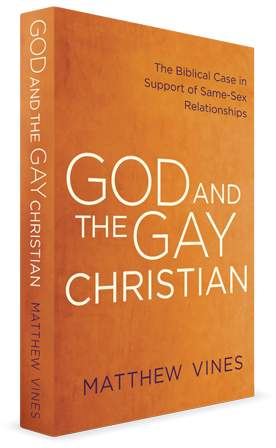I’m happy to be part of the Patheos Book Club about Matthew Vines’ book, God and the Gay Christian: The Biblical Case in Support of Same-Sex Relationships.
Patheos will be hosting a live chat with the author on May 14 at noon EST, with other guests to include Rachel Held Evans and Tony Jones.
 This book is absolute dynamite. It is quite possibly the most important book I have encountered on this subject. A lot has been written, but most of it has either been too technical, or has simply taken a negative view of same-sex relations that would only be found convincing by those already predisposed to accept that view, or has presupposed a liberal approach to the Bible which might be well and good for me, but is never going to connect with, much less convince, conservative Christians.
This book is absolute dynamite. It is quite possibly the most important book I have encountered on this subject. A lot has been written, but most of it has either been too technical, or has simply taken a negative view of same-sex relations that would only be found convincing by those already predisposed to accept that view, or has presupposed a liberal approach to the Bible which might be well and good for me, but is never going to connect with, much less convince, conservative Christians.
That is why Vines’ book is so important. It is written by a conservative Christian who is gay. It accepts the authority of Scripture. And it makes a convincing case within that framework that what the Bible says does not provide a basis for disapproving of same-sex marriage. Although Vines is not a scholar, by drawing on scholarship and carefully investigating the subject, he comes up with interpretations of the relevant Biblical texts, against the backdrop of their cultural setting, that are thoroughly persuasive.
It is a remarkable achievement. I can well imagine that a century from now, people may look back to this book as the one that decisively turned the tide regarding conservative Christians views on homosexuality.
The first chapter introduces the book, offering some autobiography while also tackling the question of whether it is appropriate to allow one’s experience to impact the way that one thinks about the teaching of Scripture. Vines points out that the Bible itself asks people to look at the fruit that is produced by people and by teachings. An overview is offered of the arguments to be explored in the rest of the book.
The second chapter starts with Galileo and how new information requires us at times to let go of earlier interpretations of Scripture. A similar paradigm shift is of course occuring in our time, with lots of new information about same-sex attraction. But there is other relevant data, and much of this chapter is devoted to exploring the evidence about what ancient people, especially in Biblical times, thought about same-sex intercourse. It turns out that there is no discussion whatsoever in ancient literature of people who have an exclusive attraction to people of the same gender or the opposite gender. For most men in the Greco-Roman world, sex with other men was not an alternative to sex with women, but something which was pursued, in the eyes of critics, because of the insatiability of their lusts, seeking novel pleasures. The main criticisms of same-sex relations were when two people of the same age and social status engaged in them, since, because of the preevailing patriarchal values, it was felt to be demeaning for a male to take the passive role appropriate to inferior females. The implications of the survey of primary texts as well as scholars is that “There are no Christians today who hold truly traditional views on homosexuality” (p.33).
Chapter 3 focuses on celibacy, noting that there is no suggestion anywhere in the Bible that people may have natural attraction to people of the same gender and that they are called to celibacy. The Biblical and later the mainstream church’s stance is consistently that some people are called to celibacy, and that it is perilous for those who are not so called to try to be celibate.
Chapter 4 looks at the meaning of the story of Sodom and Gomorrah, noting that the attempted same-sex act in the story was gang rape, which is wrong regardless of whether the victim is male or female, as Judges 19 shows. The history of interpretation is surveyed, tracing when and why same-sex intercourse becomes part of the picture. In light of the considerations earlier in the book, it is noted that, even when the focus does shift away from hospitality to same-sex lust, the point of view expressed is still not that of modern non-affirming Christians.
Chapter 5 looks at the abominations of Leviticus, seeking to go deeper than either the one side that says “homosexuality is an abomination” and the other that says “so is shellfish” (p.80). The chapter shows that not all rules about sexuality found in Leviticus carried over into Christianity, and thus Leviticus cannot be cited simplistically on the matter. The chapter then turns to the deeply misogynistic culture of the ancient world, noting the following about what ancient authors do and do not say about men and women and sex: “They don’t talk about the design of male and female bodies – there is no mention of anatomical complementarity. Instead, they base their rejection of same-sex relations on a different belief: Because women are inferior to men, it is degrading for a man to be treated like a woman” (p.91). And again, “the entire question of how bodies fit together doesn’t seem to be on the radar. The concern we see instead is centered around the proper ordering of roles in a patriarchal society” (p.93). Hence the main foundation of modern conservative Christian opposition to same-sex relations, namely anatomical compatibility, isn’t even mentioned, much less a central focus, in the Bible or other ancient texts on the topic.
Chapter 6 deals with what Paul says in Romans, saying “There is no question that Romans 1:26-is the most significant biblical passages in this debate” (p.98). A key point is that, just as with any other instructions encountered in the New Testament, we need to ask why Paul wrote what he did, so that we can understand the underlying principle and its application, and then seek how to relate that to our current context. Vines concludes that Paul was not speaking about “homosexuality” in the sense that we use that term today: “The context in which Paul discussed same-sex relations differs so much from our own that it cannot reasonably be called the same issue” (p.109). For Paul, the issue was not the appropriateness of people with an innate attraction for the same sex entering into a lifelong covenant of marriage, but what he like many of his contemporaries viewed as excessive lust expressing itself in seeking sex with men in addition to with women. A helpful treatment of the difference between what “nature” and “unnatural” meant in Paul’s time and what it means in ours is provided.
Chapter 7 tackles the words malakoi and arsenokoitai. A survey of past translations highlights that it is only recently that the former was connected with same-sex intercourse. It has to do with being “effeminate,” and in the ancient viewpoint of Paul’s time, that meant being weak and not keeping your passions under control – so that what might seem to some today to be odd, an effeminate womanizer, was a commonplace in ancient literature (p.123). The two words are never used as a pair to indicate those who engaged in same-sex relations (while other terms did have those connotations – see p.129). And the context in which arsenokoitai appears in vice lists suggests that it had not only or primarily a sexual connotation, but one that also involved economic exploitation.
Chapter 8 then moves from showing that these texts are not about committed same-sex marriages in our context, to making a positive case for same-sex marriage from the Bible. A key question is asked: “Can we translate basic biblical principles about marriage to this new situation without losing something essential in the process?” (p.139). In the story in Genesis 2, the joy of finding a life partner is articulated not in terms of difference, such as different sexual organs or other notions of “gender complementarity,” but in terms of sameness – here now I’ve found one who is flesh of my flesh and bone of my bone!
Chapter 9 is about the image of God, and highlights the fact that, since same-sex attraction is part of who a person is, teaching someone to hate this may be teaching them to hate themselves. Vines writes (p.163):
Yes, plenty of Christian teachings are hard for us to live out. But no other teaching that Christians widely continue to embrace has caused anything like the torment, destruction, and alienation from God that our rejection of same-sex relationships has caused. When we tell people that their every desire for intimate, sexual bonding is shameful and disordered, we encourage them to hate a core part of who they are. And when we reject the desire of gay Christians to express their sexuality within a lifelong covenant, we separate them from our covenantal God, and we tarnish their ability to bear his image.
He adds (p.166):
Instead of making gay Christians more like God, as turning from genuine sin would do, embracing a non-affirming position makes them less like God. In the final analysis, it is not gay Christians who are sinning against God by entering into monogamous, loving relationships. It is we who are sinning against them by rejecting their intimate relationships.
Vines pulls no punches.
In chapter 10, the final chapter of the book, Vines calls readers to act, to turn our response to the arguments in the book into concrete practice, whether by getting involved in a new reformation, or merely learning to accept gay Christians who have sincerely reached a different conviction than you based on Scripture.
My own support for same-sex marriage was closely connected with my “coming out” as a liberal Christian. I saw clearly for the first time the harm caused by the negative view of gays and lesbians among many Christians and Christianists. I was already a liberal, but a rather timid one, rarely outspoken. Seeing the harm that the form of Christianity I once espoused was having on people in general, and one colleague in particular, made me decide to speak out. Vines tells the story of Christians more conservative than myself who had a similar experience, and who even had their views changes by it. One example he offers is Jim Brownson, a seminar professor who found that his assumptions and answers did not work when he sought to apply them when his own son came out as gay.
Vines’ book is full of sound contextual exegesis. None of it bothered me or seemed dubious to me from my perspective as a liberal, but none of it is a liberal interpretation or based on a liberal view of the Bible.
That is what makes this book dynamite. And that is what makes this book seem so dangerous to those who want to defend the conservative Christian status quo.
I highly recommend Vines’ book. When you read it, I’ll be interested to hear your thoughts on it. Whether you agree with his conclusions or not, I am persuaded that no one can read this book and not come to think that same-sex marriage is a subject about which conservative Christians can disagree without needing to anathematize or break fellowship with those who have different views. Vines shows that you can support same-sex marriage without abandoning your high view of Scripture.
And so I recommend buying at least two copies. Keep one for yourself, and pass the second one on to a conservative Christian you know who thinks that the Bible simply condemns same-sex relations. I expect that it will lead to fruitful conversations. And I anticipate the same thing happening throughout the church.
I can hardly wait to see the impact this book has.
For more, click through to the book website to read a sample, and/or watch the video below, courtesy of Convergent Books.













